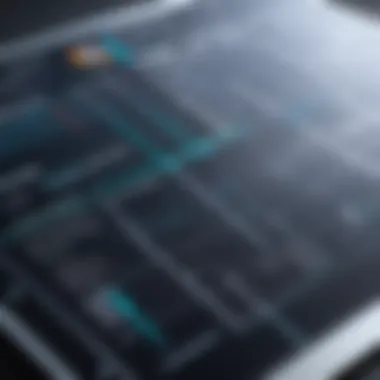Material Take Off Applications in Construction


Intro
Material take off applications represent a vital aspect of the construction industry. They play a crucial role in ensuring accurate estimates of resources required for a project. This involves distinguishing various materials like concrete, steel, or timber needed in precise quantities. Understanding these applications is important for making informed decisions concerning budgeting, procurement, and scheduling.
These tools leverage advanced technology to improve efficiency. With the construction industry growing in complexity, the necessity for accurate estimations becomes ever more pertinent. The following sections will delve into the key features and functionalities of material take off applications, target users, and other essential aspects that contribute to enhanced project management.
Key Features and Functionalities
Material take off applications are designed with several functionalities that streamline the estimation process. These features significantly contribute to efficiency in construction management.
Comprehensive Overview
The primary features of these applications include:
- User-Friendly Interfaces: Most applications prioritize intuitive design, making it easy for users to navigate and utilize effectively.
- Automatic Calculations: Automated features reduce manual input errors, ensuring accuracy in material quantity estimations.
- Integration with Other Software: Compatibility with project management tools, such as Microsoft Project or AutoCAD, allows for seamless data transfer and project oversight.
- Custom Reporting: Users can generate reports tailored to specific needs, providing insights into material usage and costs.
Overall, the proper functionality of a material take off application can influence project outcomes profoundly.
Target Users
The users of material take off applications include a range of professionals within the construction sector:
- Estimators: Those responsible for assessing project costs will benefit significantly from using precise material estimations.
- Project Managers: Equipped with reports and insights, these individuals can make informed decisions during the project's lifecycle.
- Contractors and Subcontractors: They need accurate material counts to ensure proper resource allocation and scheduling.
The adaptability of these applications to various roles demonstrates their relevance across different stages of a construction project, ensuring stakeholders have the information required for successful outcomes.
Pricing Models and Cost Analysis
Understanding the financial aspects of material take off applications is essential for decision-makers. The pricing models can vary widely based on functionalities and target users.
Breakdown of Pricing Tiers
Material take off applications often come in several pricing models:
- Subscription-Based Models: Monthly or yearly subscriptions allow users to access features without significant upfront investment. Examples include PlanSwift and Bluebeam.
- One-Time Purchase: Some applications, like CAD-Estimator, offer a one-time purchase option, which may be cost-effective for long-term use.
- Tiered Pricing: Certain tools, like Viewpoint Vista, provide different tiers of service, depending on organizational needs.
Additional Costs to Consider
When looking at cost, potential additional expenses might include:
- Training Costs: Users may require training to use advanced features efficiently.
- Integration Fees: If the application needs to integrate with existing systems, there may be extra charges involved.
- Support Services: Investing in technical support can also add to the overall cost, ensuring proper functioning.
Determining the budget for material take off applications is a vital step for decision-makers. By considering an application’s features and associated costs, stakeholders can select tools that align with their project management needs.
"Accurate material take off is integral to project success. A small error can lead to significant cost overruns."
By thoroughly examining both the functionalities and pricing models of material take off applications, decision-makers can navigate the landscape more effectively. The insights gathered can guide choices that enhance overall efficiency and project delivery.
Understanding Material Take Off Applications
Material take off applications serve a fundamental role in the construction industry. They provide a systematic way to quantify materials required for a project. Understanding these applications is crucial for industry professionals, such as estimators, project managers, and contractors. Accurate material take off not only supports budgeting but also helps in efficient project scheduling and resource allocation.
In today’s fast-paced construction environment, the precision and efficiency offered by these applications are essential. Key considerations include the ability to integrate with other software tools and maintain data accuracy. With advancements in technology, these applications now offer automation capabilities that significantly reduce human error and labor time.
Definition of Material Take Off
Material take off refers to the process of listing all materials needed for a construction project. This involves measuring quantities from architectural and engineering drawings. The output is typically a detailed Bill of Materials (BOM). This list serves as a foundation for cost estimation and procurement planning.
To perform material take off, professionals use various tools, from manual methods to sophisticated software applications. The choice of method can significantly impact the efficiency and accuracy of the material take off process.


Importance in Construction Projects
The importance of material take off in construction projects cannot be overstated. It ensures that all materials are accounted for, minimizing waste and reducing unexpected costs.
Some critical benefits include:
- Improved Accuracy: Automated applications tend to deliver higher accuracy compared to manual calculations.
- Enhanced Time Efficiency: Quick quantification of materials speeds up the planning phases of a project.
- Cost Management: Accurate material take offs directly influence project budgets, enabling better financial control.
Key Features of Material Take Off Apps
In the realm of construction, the utilization of material take off applications enhances precision and efficiency. These applications are crucial for various reasons, including streamlining project workflows, reducing human error, and providing accurate estimates. When evaluating material take off apps, several features stand out as essential for successful integration into construction management processes.
Automation Capabilities
One significant advantage of modern material take off applications is their automation capabilities. Automation speeds up the estimation process, which is often labor-intensive and time-consuming when done manually. By employing automated data extraction from digital blueprints, these apps reduce the likelihood of errors that often arise during manual entry.
Additionally, automation allows for quick revisions of estimates when project changes occur. As projects evolve, the ability to automatically update quantities and costs in real-time is invaluable. This feature significantly minimizes the response time in project planning, enabling teams to adapt promptly without compromising accuracy.
Integration with Other Software
Another key feature of material take off applications is their integration capabilities with other software systems. Effective integration means that these tools can work seamlessly with project management software, accounting systems, and design applications. This eliminates data silos and promotes collaboration across different departments within a construction firm.
For example, systems like Autodesk Revit or Sage Estimating can interface directly with material take off apps, allowing for a synchronized flow of information. Decision-makers benefit from comprehensive data analysis, as insights from each software tool are readily accessible. Through integration, stakeholders gain a holistic view of the project landscape, fostering informed decision-making.
User-Friendly Interface
Having a user-friendly interface is essential for material take off applications. Simplicity in design ensures that users can navigate the application without extensive training. A clean layout with intuitive controls allows project managers and estimators to perform tasks efficiently.
Furthermore, a well-designed interface often features customizable dashboards that enable users to tailor their experience according to specific project needs. This adaptability contributes to quicker adoption rates amongst teams and enhances overall productivity. Thus, the complexity of construction estimates becomes easier to manage, significantly improving user engagement within the application.
"The right material take off application can transform how construction companies manage resources, saving time and reducing costs significantly."
In summary, the key features of material take off applications primarily revolve around automation, integration, and user-friendliness. These elements play a pivotal role in improving the efficiency of construction projects, allowing companies to maintain competitiveness in a rapidly evolving industry.
Types of Material Take Off Applications
When discussing material take off applications, it is crucial to explore the various types available in the market. These applications serve as essential tools for construction professionals, enabling precise estimation of materials required for projects. Each type has its unique features and benefits, catering to different needs and preferences in the industry.
Dedicated Estimation Software
Dedicated estimation software focuses specifically on the material take off process. These applications are built with robust features that allow users to input detailed project information. The software often includes templates for common material types, which saves time and reduces errors. Additionally, these programs can provide historical data for similar projects, facilitating better estimates.
Users benefit from their automated functions, which minimize manual calculations. The intricacy of the construction processes demands accuracy and detail, making dedicated estimation software invaluable. Examples include programs like Bluebeam Revu and STACK. These solutions are designed to be intuitive, but the depth of their functionality can support complex estimation scenarios, which is frequently encountered in large-scale projects.
Project Management Tools with Estimation Features
Project management tools that include estimation features serve a dual purpose in construction. They not only facilitate the overall management of a project but also cover material take offs. This integration means users can manage timelines, budgets, and materials from a single platform. Solutions like Procore and CoConstruct provide a comprehensive approach where estimating modules combine with project scheduling and resource allocation.
The advantage of this type of application is seamless workflows. Project managers can track changes in real-time, ensuring that material requirements align with project updates. These tools also enhance communication among team members, which is crucial in minimizing misunderstanding and ensuring all parties are on the same page.
Spreadsheet-Based Applications
Spreadsheet-based applications are among the most flexible tools for material take off. Programs like Microsoft Excel or Google Sheets do not inherently specialize in estimation but can be customized to perform take offs through templates and formulas. Users can create their own structures based on their unique project needs. They often utilize built-in features to manipulate and analyze data effectively.
The primary appeal of spreadsheets lies in their accessibility. Many professionals are already familiar with spreadsheet software, thus reducing the learning curve. However, using spreadsheets for material take offs requires discipline in keeping information organized and accurate, as manual entry can lead to errors. This option suits smaller projects or teams with less budget for specialized software, providing a cost-effective solution for material estimation.
Benefits of Using Material Take Off Apps
Material take off apps have become essential tools in the construction industry. Their significance plays a major role in the accuracy of project estimation and overall efficiency. When professionals rely on these applications, they can manage materials in a more effective manner. Here, we will delve into several benefits of using these apps, emphasizing areas like accuracy, time efficiency, and cost management insights.
Improved Accuracy in Estimation


One of the main advantages of material take off applications is the drastic improvement in estimation accuracy. Manual calculations are prone to errors and inaccuracies, which can lead to budget overruns and project delays.
With advanced software like Assembly Estimator and Bluebeam Revu, you can input exact specifications and automatically generate precise material quantities. This process reduces the risk of human error. Moreover, precise estimations foster more informed decision-making.
Key elements that contribute to improved accuracy include:
- Digital Measurements: Many apps offer tools for measuring directly from project drawings.
- Database Integration: Access to supplier databases ensures that measurements directly correspond with available products.
- Real-Time Updates: Adjustments in designs or materials can be accounted for immediately, maintaining accuracy throughout the project's lifecycle.
"Efficient material estimation helps in achieving cost savings, which is critical for project feasibility."
Time Efficiency in Project Planning
Time management is another critical area where material take off apps shine. These applications automate many aspects of planning, freeing professionals from tedious manual tasks. Instead of investing hours in calculations and data entry, users can focus on strategic project elements.
Features that enhance time efficiency include:
- Automated Quantity Takeoffs: This speeds up the process of gathering material quantities, allowing estimators to produce reports quickly.
- Instant Reporting: Results can be generated and shared promptly with stakeholders, expediting the feedback loop.
- Collaboration Tools: Many applications support multiple users, allowing teams to work on the same project simultaneously, enhancing communication and reducing delays.
Cost Management Insights
The benefits extend beyond accuracy and efficiency. Material take off apps also provide vital insights for cost management. By leveraging data analytics, professionals can predict costs more effectively and adjust budgets accordingly.
The key insights provided by these apps include:
- Cost Estimation: Comprehensive reports on material costs aid in budgeting, ensuring projects stay financially viable.
- Tracking Expenses: Users can monitor real-time expenditure against planned budgets, identifying any discrepancies early.
- Supplier Comparison: Apps enable swift comparison of material costs across multiple suppliers, helping project managers choose the most economical options.
Challenges in Material Take Off Processes
Material take off processes play a pivotal role in the construction industry. They are instrumental in estimating the quantity and cost of materials required for projects. However, various challenges emerge during these processes that can hinder accuracy and efficiency. Understanding these challenges is vital for decision-makers and IT professionals involved in the selection and implementation of material take off applications. This awareness not only guides the choice of tools but also informs strategies for overcoming these obstacles.
Data Accuracy and Integrity
Data accuracy is central to successful material take off. The reliance on precise information means that any inaccuracies can lead to significant consequences, including budget overruns and project delays. Ensuring data integrity involves thorough checks and balances throughout the estimation process. Inaccurate measurements, incorrect entry of quantities, or errors in data integration from multiple sources can significantly impact the overall calculations.
Moreover, fluctuations in material costs and availability add another layer of complexity. For instance, if the software being utilized lacks real-time data integration capabilities, decision-makers may find themselves working with outdated information. Integrity issues can arise if data sources are not standardized or updated regularly, leading to questions about the reliability of the estimates produced. It is therefore essential to implement robust data validation measures and invest in trustworthy software that ensures high levels of data accuracy and integrity throughout its processes.
Training and Skill Development Needs
Another significant challenge is the need for adequate training and skill development among team members who utilize material take off applications. The adoption of advanced software tools necessitates a certain level of proficiency and understanding of the functionalities offered. Organizations often face barriers when existing staff members lack the necessary skills to effectively use these applications.
The implications are clear: inadequate training can lead to inefficiencies, incorrect estimations, and poor decision-making. Therefore, it is essential for companies to prioritize the training of their personnel. By offering structured training programs, organizations can enhance the competency of their teams, leading to smoother operations and better project outcomes. Furthermore, continuous learning opportunities can adapt as technologies evolve, ensuring that teams remain proficient in ever-changing environments.
Resistance to Technology Adoption
Resistance to technology adoption is yet another hurdle in the execution of material take off processes. Some employees may be accustomed to traditional methods and hesitant to transition to digital solutions. This resistance can stem from a variety of factors, including fear of the unknown, perceived complexity of new software, or a belief that existing methods are sufficient.
Addressing this resistance requires a strategic approach. Leadership must communicate the benefits of adopting new technologies, such as increased efficiency, improved accuracy, and simplified workflows. Demonstrating early successes with pilot implementations can also help to encourage wider acceptance among the team. When personnel understand the advantages and see tangible results, they are more likely to embrace change rather than resist it.
Comparative Analysis of Popular Material Take Off Apps
A comparative analysis of material take off applications is essential in this article as it provides insights into the wide range of software currently available in the construction industry. Each application offers distinct features, capabilities, and user experiences that can impact project outcomes. By understanding these variations, decision-makers can select tools that align with their specific needs, streamlining the estimation and planning processes in their projects.
Overview of Leading Software Options
Several popular material take off applications have emerged, each designed to address varying project needs. Trustworthy options include PlanSwift, Bluebeam Revu, and CostX. Each app has its unique strengths:
- PlanSwift: This software is known for its efficient takeoff capabilities. It allows users to quickly measure and calculate material needs from digital drawings.
- Bluebeam Revu: Renowned for its user-friendly design and collaboration features. It includes tools for markup, measurement, and seamless file sharing.
- CostX: This app integrates with many types of project management software, providing strong estimation features and customizable templates.
Feature Comparisons


When evaluating different applications, several key features are worth comparing:
- Ease of Use: Navigation and functionality are critical. Apps like Bluebeam Revu often rank well due to their intuitive interfaces.
- Integration Capabilities: The ability to interface with other software like Microsoft Excel or project management tools is vital. CostX is seen as superior in this regard.
- Automation Features: Automation can save time and reduce errors. PlanSwift offers advanced takeoff automation tools that many users find beneficial.
- Reporting and Analytics: The depth of reporting varies by application, with some providing detailed insights into material costs and quantities.
User Experiences and Feedback
User experiences play a significant role in understanding how these applications perform in real-world settings. Feedback can highlight strengths or weaknesses that might not be apparent in feature lists:
- Users often praise PlanSwift for its speed but mention a steeper learning curve for beginners.
- Bluebeam Revu is frequently celebrated for its collaboration tools, though some users report that it can be resource-intensive on certain devices.
- CostX appeals to those in larger firms due to its adaptability, but new users might find the initial complexity challenging.
"Choosing the right material take off application is not just about features. It’s also about how well it integrates into your existing workflow and meets your project’s demands."
Future of Material Take Off Applications
The future of material take off applications is a critical area of focus within the construction industry. As projects become more complex, the need for precise material estimation has increased. Emerging technologies present not only advancements in efficiency but also a shift in how construction professionals approach project management. Thus, understanding these trends becomes essential for decision-makers looking to maintain a competitive edge.
Emerging Technologies and Innovations
Emerging technologies are shaping the landscape of material take off applications. The rise of cloud computing allows teams to access and update material lists in real-time from various locations. This accessibility optimizes collaboration. Additionally, improvements in mobile device capabilities enable project managers to conduct take-offs on-site, enhancing accuracy.
- 3D Scanning: This technology allows for precise measurement of existing structures, facilitating better estimations.
- BIM (Building Information Modeling): The integration of BIM into material take-off apps has revolutionized how materials are processed, enabling a more holistic view of project requirements.
Other innovations such as drones for site surveys can provide a detailed overview of the work site, leading to more informed material calculations. The adoption of these technologies is crucial for any construction firm aiming to increase efficiency and reduce waste.
Influence of Artificial Intelligence
Artificial Intelligence is poised to significantly impact material take off applications. With AI, software can learn from past projects, improving the accuracy of estimates over time. AI algorithms can analyze large datasets, identifying patterns that a human estimator may overlook.
Using AI can also streamline workflows. For example, natural language processing enables users to input data conversationally, which the software then translates into actionable information. This contributes to reducing the time spent on manual data entry.
- Predictive Analytics: These tools help forecast material needs based on historical data and current project parameters.
- Error Reduction: AI systems can flag inconsistencies in data, minimizing the risks associated with human errors.
Such advancements not only accelerate project timelines but also enhance overall quality, a vital consideration in construction.
Continuous Integration of Industry Standards
Continuous integration of industry standards is essential to maintain competitive advantage in material take off applications. As new regulations arise, software must adapt to ensure compliance. This adaptability ensures that firms can mitigate risks associated with regulatory hurdles, thus securing project viability.
- Standard Compliance: Software solutions that automatically align with updated building codes make compliance less daunting for construction teams.
- Best Practices: Integrating standard methodologies within software can facilitate uniformity across projects, resulting in better training resources and overall project coherence.
Moreover, integration with industry bodies is crucial. Collaborations with organizations such as the International Society of Automation can lead to the development of guidelines that all material take off applications adhere to. Such efforts promote best practices within the industry, allowing firms to operate at peak efficiency.
"To thrive in the future construction landscape, leveraging technology and adhering to updated standards is indispensable."
In summary, the future of material take off applications hinges on technological innovation and standard compliance. By embracing these elements, construction professionals can ensure precise estimations, enhance efficiency, and adapt quickly to changing industry landscapes.
End and Recommendations
In the context of material take off applications in construction, the conclusion and recommendations section serves as a crucial wrap-up. This part synthesizes the information explored in earlier sections, reinforcing the importance of utilizing the right tools in project management. The construction industry relies heavily on accurate material take off processes to reduce costs, manage resources effectively, and ensure project timelines are met.
Utilizing these applications can significantly impact the efficiency of project management, leading to more informed decision-making. As such, it is essential for decision-makers, IT professionals, and entrepreneurs to carefully consider the insights presented in this article when approaching material estimation.
"Selecting the appropriate material take off application is as vital as the planning stages of any construction project."
Summary of Key Insights
The investigation into material take off applications has uncovered several critical insights that should guide future choices. Some of the vital points include:
- Accuracy and Efficiency: Material take off applications enhance the precision of cost estimation. This minimizes the risk of budget overruns.
- Integration Capabilities: The ability of applications to integrate with existing project management tools ensures continuous workflow and coherence.
- User Experience: A user-friendly interface is crucial for ensuring that team members can adapt to and utilize the software effectively.
Overall, these insights emphasize the need for a strategic selection process.
Guidance for Selecting Appropriate Tools
When considering the selection of material take off tools, several factors should be examined:
- Functionality: Assess whether the application meets specific project requirements. Look for features that align closely with your unique processes.
- Scalability: Ensure that the tool can grow with your projects. This allows for future expansion without needing to transition to another system.
- Training and Support: Consider the availability of training resources and customer support. A strong support system will aid in the smooth adoption of new software.
- Cost Considerations: Evaluate pricing models, ensuring they align with your budget constraints while providing value for money.















